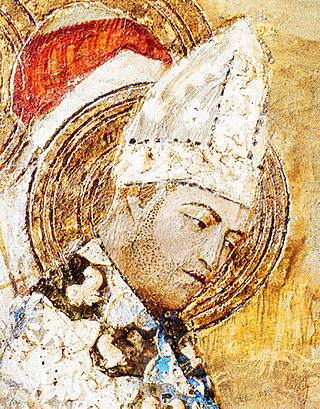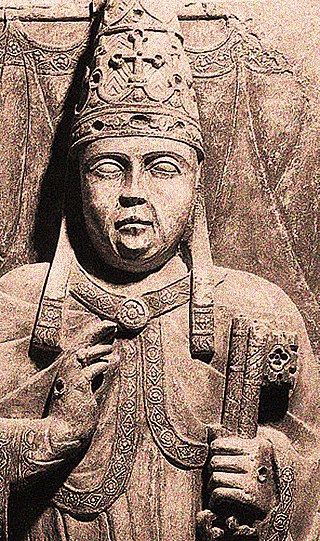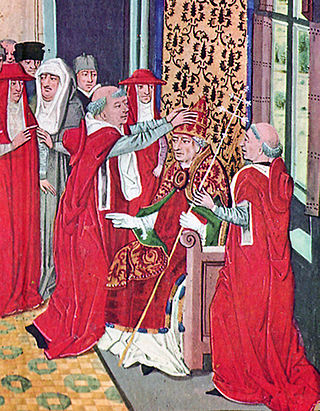
Pope Clement VI, born Pierre Roger, was head of the Catholic Church from 7 May 1342 to his death in December 1352. He was the fourth Avignon pope. Clement reigned during the first visitation of the Black Death (1348–1350), during which he granted remission of sins to all who died of the plague.

Guy de Malsec was a French bishop and cardinal. He was born at the family's fief at Malsec (Maillesec), in the diocese of Tulle. He had two sisters, Berauda and Agnes, who both became nuns at the Monastery of Pruliano (Pruilly) in the diocese of Carcassonne, and two nieces Heliota and Florence, who became nuns at the Monastery of S. Prassede in Avignon. He was a nephew of Pope Gregory XI, or perhaps a more distant relative. He was also a nephew of Pope Innocent VI. Guy was baptized in the church of S. Privatus, some 30 km southeast of Tulle. He played a part in the election of Benedict XIII of the Avignon Obedience in 1394, in his status as second most senior cardinal. He played an even more prominent role in Benedict's repudiation and deposition. Guy de Malsec was sometimes referred to as the 'Cardinal of Poitiers' (Pictavensis) or the 'Cardinal of Palestrina' (Penestrinus).

Hélie de Talleyrand-Périgord was a French Cardinal, from one of the most aristocratic families in Périgord, south-west France. Hélie was born at Périgueux, third son of Elias VII, Count of Périgord, and Brunissende of Foix, daughter of Roger Bernard III, comte de Foix. His elder brothers were Archambaud (IV), who inherited the County, and Roger-Bernard ; his younger brother was Fortanier, and his sisters were Agnes, Jeanne, Marguerite, and Rosemburge. As a third son Hélie was destined for an ecclesiastical career. His brother, Roger Bernard, too, had an ecclesiastical career, becoming Canon of Lyon. But then, the eldest son died, and Roger-Bernard became the Count of Périgord. Hélie became a major figure in the Avignon papacy, and also a diplomat engaged in the negotiations of the Hundred Years' War, having friendships in both English and French royal families. In his last months he had been appointed Papal Legate for a crusade against the Turks.

The Diocese of Bazas, centred on Bazas in Aquitaine, covered the Bazadais region, known under the Romans as the Vasatensis pagus after the ancient occupants, the Vasates. In the 2nd century it was part of the Novempopulania, one of the seventeen provinces of Gaul. The diocese must have been created between the first and the third centuries, but because of the large numbers of invaders that passed through this region - Arians, Saracens, Normans - the list of bishops is much reduced during the first millennium. The first bishop of this diocese is mentioned, without a name, by Gregory of Tours in his De gloria martyrum.

Pierre Desprès (1288–1361) was a French Cardinal during the period of the Avignon Papacy.

Audouin Aubert was a French jurist, bishop and Cardinal.
Napoleone Orsini was a Roman Cardinal. His ecclesiastical career lasted 57 years, 54 of them as a cardinal, and included six conclaves.

Bertrand des Bordes was a bishop of the Diocese of Albi and Roman Catholic Cardinal. He served as Chamberlain of Pope Clement V from 1307 to 1311.

The papal conclave held from 13 to 20 December 1334 elected Jacques Fournier to succeed John XXII as pope. Fournier took the name Benedict XII.

Guy of Boulogne was a statesman and cardinal who served the Avignon Papacy for 33 years. He participated in the papal conclaves of 1352, 1362 and 1370, and was the Subdean of the Sacred College of Cardinals. His diplomatic postings were extensive, including Hungary, Italy, and Spain. He headed an effort to end the Hundred Years' War. The historian Kenneth Setton called him "one of the commanding figures of his day, and the letters of Petrarch abound with references to him".

Nicolas de Besse was born in the diocese of Limoges, in 1322. He was a French bishop and Cardinal. He was the son of Jacques de Besse, Seigneur de Bellefaye and Almodie (Delphine) Roger, sister of Pope Clement VI. He had a brother Pierre de Besse, who became Seigneur de Bellefaye and who married Margueritte de Thiers. Nicolas de Besse died in Rome on 5 November 1369.

Guillaume d'Aure, OSB, was born in Toulouse, France and died on 3 December 1353 in Avignon. He was a French Benedictine monk and Cardinal. He was the son of Bernard VII Dodon, Count of Comminges, and Bertrande, Countess d'Aure, daughter of Arnaud, Vicomte de l'Arboust. He had a brother, Raymond Roger d'Aure.

Imbert du Puy was a French Cardinal of the fourteenth century. He was a nephew of Pope John XXII.

Bernard d'Albi was a French cardinal of the 14th century. He was born at Saverdun in the diocese of Pamiers in the foothills of the Pyrenees, south of Toulouse and died on 23 November 1350 at Avignon.

Bertrand de Déaulx was a French bishop, diplomat and Cardinal. He was born, perhaps around 1290, in Castrum de Blandiaco in the diocese of Uzès; or in Déaulx. He died in Avignon in 1355. Trained as a lawyer and teacher of law, he practiced in the papal courts, and became an arbitrator and diplomat for the Papacy. He had several assignments in Italy and one in Catalonia. He was responsible for the reorganization of the University of Montpellier and the granting of revised charters.

Pasteur de Sarrats was a French Franciscan friar, bishop and Cardinal. He was born in the village of Aubenas in the Vivarais, or he took his monastic vows in the monastery of Aubenas. Pasteur may have had a brother. A bull of Benedict XII, dated 13 April 1337, grants the parish church of S. Martin de Valle Gorgia in the diocese of Viviers to Pierre de Serraescuderio, Canon of Viviers since 1333, who held a parish of S. Pierre de Melon in the diocese of Uzès. Pasteur died in Avignon in 1356.

Raymond de Canillac was a French lawyer, bishop, and cardinal. He was born at Roche de Canilhac, the family castle, in the diocese of Mende in the Gevaudan in central France, the son of Guillaume de Canillac and a sister of Cardinal Bertrand de Déaulx. Both of his uncles, Pons and Guy, were successively abbots of Aniane, as was a nephew of the Cardinal, also called Pons. In 1345 his niece Garine, the daughter of his brother Marquis and of Alixène de Poitiers-Valentinois, married Guillaume Roger, Vicount of Beaufort, the brother of Cardinal Pierre Roger de Beaufort, who became Pope Clement VI. Raymond became a member of the Canons Regular of Saint Augustine (CRSA). He studied law at the University of Montpellier, and obtained the degree of Doctor in utroque iure.

Pierre de Thury was a French bishop and cardinal of the Avignon Obedience, who served as a royal secretary and Master of Requests, and then as papal Nuncio and Apostolic Legate on several occasions. He participated in two papal elections, those of 1394 and 1409, and was a prominent member of the Council of Pisa in 1409.

Niccolò Brancaccio was born in the Kingdom of Naples, perhaps in Naples itself. He was Archbishop of Bari and then Archbishop of Cosenza, while serving in the Roman Curia in Avignon. He became a cardinal of the Avignon Obedience in 1378, and was Cardinal Priest of Santa Maria in Trastevere and then Cardinal Bishop of Albano. He participated in the Council of Pisa in 1409, and was one of the electors of Pope Alexander V and of Pope John XXIII.

Pierre Girard was born in the commune of Saint-Symphorien-sur-Coise, in the Department of Rhone, once in the ancient County of Forez. He died in Avignon on 9 November 1415. He was Bishop of Lodeve and then Bishop of Le Puy. He was a cardinal of the Avignon Obedience during the Great Western Schism, and was promoted to the Bishopric of Tusculum (Frascati). His principal work, however, was as a courtier and administrator at Avignon, and as a papal diplomat.









